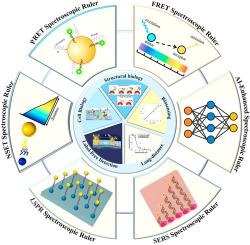用于高级传感的纳米尺度光谱尺:从单分子检测到智能生物传感器
IF 12
1区 化学
Q1 CHEMISTRY, ANALYTICAL
引用次数: 0
摘要
生物传感领域正在从微观分辨率过渡到纳米级分辨率,克服了光学衍射、标记伪影和集合平均的限制。纳米尺度光谱尺利用量子尺度机制,包括近场耦合能量转移(FRET/NSET/PRET)和局部场增强(LSPR/SERS),以实现Ångström-level分辨率,单分子灵敏度和活细胞兼容性。smFRET(亚纳米距离测绘)、NEST(扩展范围)和远程SERS(无标签检测)等突破重新定义了生物传感的界限。这些技术与人工智能驱动的分析和多模式集成协同作用,实现了分子构象和瞬态相互作用的实时跟踪。这些进步正在催化精准医学、神经科学和合成生物学的变革性应用。本文系统分析了纳米尺度光谱尺的设计原理、技术演变和跨学科应用,为下一代智能生物传感器的发展提供了路线图。本文章由计算机程序翻译,如有差异,请以英文原文为准。

Nanoscale spectroscopic rulers for advanced sensing: From single-molecule detection to intelligent biosensors
The biosensing field is transitioning from micro-to nanoscale resolution, overcoming limitations of optical diffraction, labeling artifacts, and ensemble averaging. Nanoscale spectroscopic rulers leverage quantum-scale mechanisms, including near-field coupled energy transfer (FRET/NSET/PRET) and localized field enhancement (LSPR/SERS), to achieve Ångström-level resolution, single-molecule sensitivity, and live-cell compatibility. Breakthroughs like smFRET (sub-nm distance mapping), NEST (extended range), and Long-Range SERS (label-free detection) redefine biosensing boundaries. These technologies synergize with AI-driven analysis and multimodal integration, enabling real-time tracking of molecular conformations and transient interactions. Such advances are catalyzing transformative applications in precision medicine, neuroscience, and synthetic biology. This review systematically analyzes the design principles, technological evolution, and cross-disciplinary applications of nanoscale spectroscopic rulers, offering a roadmap for next-generation intelligent biosensor development.
求助全文
通过发布文献求助,成功后即可免费获取论文全文。
去求助
来源期刊

Trends in Analytical Chemistry
化学-分析化学
CiteScore
20.00
自引率
4.60%
发文量
257
审稿时长
3.4 months
期刊介绍:
TrAC publishes succinct and critical overviews of recent advancements in analytical chemistry, designed to assist analytical chemists and other users of analytical techniques. These reviews offer excellent, up-to-date, and timely coverage of various topics within analytical chemistry. Encompassing areas such as analytical instrumentation, biomedical analysis, biomolecular analysis, biosensors, chemical analysis, chemometrics, clinical chemistry, drug discovery, environmental analysis and monitoring, food analysis, forensic science, laboratory automation, materials science, metabolomics, pesticide-residue analysis, pharmaceutical analysis, proteomics, surface science, and water analysis and monitoring, these critical reviews provide comprehensive insights for practitioners in the field.
 求助内容:
求助内容: 应助结果提醒方式:
应助结果提醒方式:


